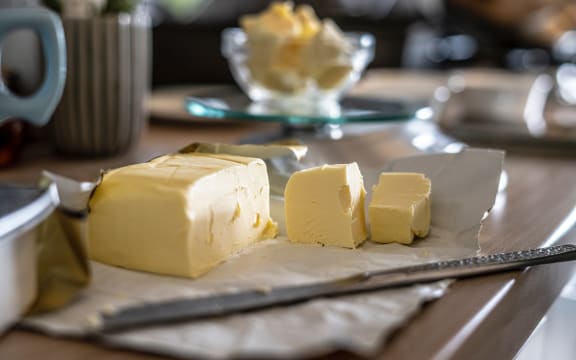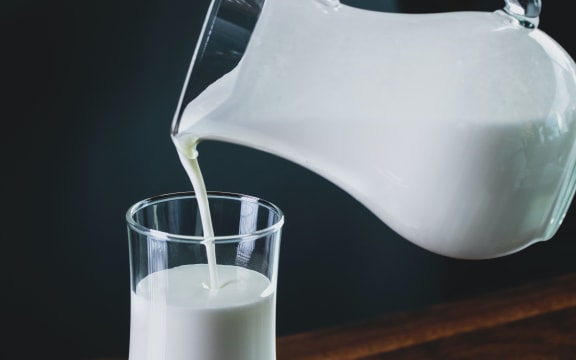Food writer and doctor Alby Hailes serves up some oven-hot tips for plant-based baking with everyday ingredients.
He also shares his go-to recipe for a versatile vegan cake.

Vegan Cake with Vegan Swiss Meringue Buttercream Photo: Alby Hailes
Mum's butter and egg-laden chocolate cake used to be a guaranteed hit at the smoko table or school bake sale, but recipes containing these ingredients no longer appeal to everyone.
Just last week, I was asked to bring a dairy-free dessert to a pot-luck so everyone could enjoy it – the block of butter on the bench almost started melting it was so upset. Given that humans have become hard-wired to crave sugary, buttery deliciousness, 21st-century bakers are having to quickly adapt to this dietary shift.
An online search for plant-based recipes reveals that their creators often lean into ‘raw’ ingredients with a very health-conscious agenda. The cost and accessibility of these ingredients can be off-putting to many cooks – not everyone has an appetite for recipes that require $20 of cashews and force you on a treasure hunt around town looking for Medjool dates.

Dr Alby Hailes Photo: Kathy Elliston
Baking is a science (as anyone who’s tried to bake macarons in a rugby clubroom oven will tell you). To successfully bake a vegan cake, it’s important to understand the chemistry involved before pulling on an apron.
Cakes are made up of four key components: liquid (eggs, dairy, fruit juice) for hydration and moistness; protein (eggs, flour, peanut butter, ground nuts) for structure; carbohydrates (flour, sugar, ground nuts) for sweetness and structure; fat (butter, oil, tahini) for flavour, lightness, mouthfeel and tenderness.
Traditional cakes usually rely on eggs and butter as part of this chemical balance, so it’s important to maintain the ratios of the four key elements when making substitutions.
Eggs, butter and liquid dairy products are the main replacement challenges to tackle when baking a vegan cake.

Photo: Jakub Kapusnak for Unsplash
Eggs are mostly water, with some protein and fat. Their proteins coagulate and set as the cake bakes, so they are critical for cake structure, and they also help to emulsify the batter. Ingredients like flour and tahini (sesame seed paste) contain protein that can replace the structural component of eggs – so vegan baking often uses more flour than normal to compensate for the absence of eggs. Bananas can also be a good binding agent, although they lack some of this protein component. Aquafaba (the brine of soaked chickpeas) contains albumin similar to egg whites so can be whipped into meringue to lighten cakes.

Photo: Sorin Gheorghita for Unsplash
Cakes often rely on butter as the primary fat contributor, bringing flavour and tenderness. When making regular cakes, I always use a combination of butter and oil, as oil remains in a liquid state at room temperature to improve the moistness of the cake. It's relatively easy to use oil (such as olive or canola) instead of butter in vegan baking. The amount of oil needed will be slightly less than the relative weight of butter (oil is pure fat, whereas butter also contains water), and you’ll need to make up the remaining weight with a water-based ingredient (e.g. plant-based milk).

Photo: Eiliv Aceron for Unsplash
Most plant-based milks work well as a direct replacement for cow’s milk (I prefer soy milk as it’s creamier, but you can also use oat, almond or coconut). The fat content varies though, so you may need to balance this with other ingredients. I usually add a tablespoon of vinegar to the milk to let it curdle slightly, which gives a similar flavour to buttermilk. Greek-style coconut yoghurt is a good substitute for cakes that call for yoghurt or sour cream. Coconut cream subs in well for cream.
With all this in mind, here’s my go-to versatile vegan cake recipe, with a bonus recipe for vegan Swiss meringue buttercream. Use this as a base to experiment with your own flavour combinations, and remember the rules about roughly maintaining the ratios of water/protein/carbs/fat when making any substitutions.]
Everyday Vegan Cake
Hands-on time: 30 minutes / Total time: 1 hour (+ cooling/icing time) / Makes one 20cm round cake / Serves 12
Ingredients - the cake:
- 250ml non-dairy milk (e.g. soy, oat or almond)
- 1 Tbsp apple cider vinegar
- 200g caster sugar
- 100ml canola oil
- 2 tsp real vanilla extract or paste
- 250g plain flour
- 1 tsp baking powder
- ½ tsp baking soda
- ½ tsp sea salt
Ingredients - vegan swiss meringue buttercream:
- 100g aquafaba (drained from 1-2 cans of chickpeas, I use Pam’s chickpeas as they have a more viscous aquafaba)
- 150g caster sugar
- 225g vegan spread (e.g. Olivani)
- 2 tsp vanilla paste
Method
Heat the oven to 160°C fan-forced (or 180°C conventional). Grease with oil and line a 20cm round cake tin with baking paper.
Whisk together the milk and vinegar in a large bowl. Set aside for 10 minutes to allow the milk to curdle a little.
Add the sugar, oil and vanilla to the milk and whisk to combine.
Sift together the flour, baking powder, baking soda and salt into the wet ingredients. Fold together until smooth and no specks of flour remain.
Pour the batter into the lined cake tin and smooth the top.
Bake for about 40 minutes, or until a skewer inserted into the centre of the cake comes out clean. Remove from the oven, place on a wire rack, and leave the cake to cool in the tin for 15 minutes. Run a knife around the edge of the tin to loosen it, then remove from the tin onto a rack to cool completely.
For the buttercream, place the aquafaba and sugar in a clean stand mixer bowl. Set the bowl over a saucepan one-third full with simmering water, ensuring the water is not touching the base of the bowl. Gently heat the aquafaba and sugar, whisking with a wire whisk occasionally, until the aquafaba is very warm and the sugar has dissolved (test this by dipping your thumb and forefinger into the aquafaba and rubbing them together – you shouldn’t feel any grains of sugar). Transfer the bowl to the stand mixer fitted with the whisk attachment. Whisk on high speed for about 10 minutes, until the meringue is relatively stiff (it won’t be as stiff as normal egg-based meringue) and the mixing bowl has cooled to room temperature. While continuing to mix on high, gradually add the vegan spread, one tablespoon at a time, mixing to combine after each addition. The mixture will collapse then curdle part way through the mixing process - just keep adding the vegan spread and it will become smooth.
To decorate, spread or pipe the buttercream over the cooled cake. Store in an airtight container at room temperature for up to three days.
Easy flavour variations:
Vegan Citrus Cake
Reduce non-dairy milk to 200ml and substitute apple cider vinegar with 75ml citrus juice (e.g. lemon, lime or orange).
Stir through the finely grated zest of either two lemons, two limes or one orange into the cake batter at the end, before pouring into the tin. Beat 1-2 Tbsp citrus juice into the buttercream at the end before icing the cake.
Vegan Chocolate Cake
Substitute 50g flour with 50g cocoa powder. Dissolve 2 tsp instant coffee granules in 1 Tbsp boiling water. Stir the coffee into the cake batter at the end.
Beat 50g melted vegan dark chocolate into the buttercream at the end before icing the cake.
The flavour combinations are endless – e.g. try adding 1 Tbsp matcha powder, or 1 Tbsp rose water, or 2 tbsp chopped fresh herbs (e.g. thyme, basil) in the cake batter to any of these combinations.
Finish with some chopped flat-leaf parsley and fresh thyme.

